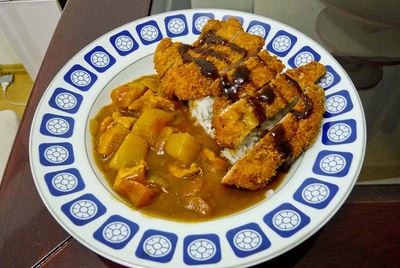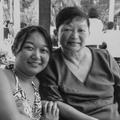In my childhood, I thought that all Brazilian families had a rice cooker at home. Not only that, I imagined that it was usual for Brazilians to eat misoshiru in the cold weather and eat tamago-gohan when there was not a side dish. Do you know what tamago-gohan is? The tamago-gohan is a mixture of egg with rice and the directions are very simple: just mix a raw egg with a little soy sauce (shoyu) and place it over the Japanese rice, preferably warm, in a bowl. After mixing it all together, your tamago-gohan is ready! It may seem a little strange, since due to the dangers of Salmonella we’re not in the habit of eating raw eggs anymore. It used to be more common to appreciate tamago-gohan. I miss my childhood!
When my mother used to bring chikuwa for us, she used to slice it into pieces and we’d eat these slices, watching television together. For lunch or barbecue at the club, she used to capriciously prepare onigiris . In the New Year celebrations, if there was no mochi, it just didn’t feel right.
I honestly do not remember when it was that I began to realize that there was something culturally different between my family and my schoolmates´ families, but in the 1990s, when I was a teenager, I remember that my friends did not like the appearance of our gohan. They had no great desire to try it and Japanese rice was dubbed “Unidos, venceremos” (a popular Portuguese saying literally translated to “joined, win” meaning that the union is strength; together, there will be no defeat. Japanese rice is known as “Unidos, venceremos” because it is sticky.) The period of my adolescence was a period of culture shocks.
The neighborhood where I live is known as one of the areas of highest concentration of Nikkei in Sao Paulo. In this neighborhood it is common to find on sale at the flea market (open air market for fruits, vegetables and meats), many of the eastern gastronomic world food: nira, imo, gobo, kabocha, nigagori (goya), horenso (spinach), chingen (which is actually the Chinese spinach), tofu, nashi (pear). Being able to find all these products close to my home, it's a great way to soften the longing of Japan.
It is interesting to stop and think about how the Japanese cuisine became so appreciated in Brazil. In Sao Paulo, there are over 250 Japanese restaurants. Not including the restaurants "per kilogram", where sushi is frequently found. In this type of restaurant, common in Sao Paulo and in some other states, you choose the food available on the buffet, put the desired items on your plate and pay for the equivalent weight. Of course, there are recipe inventions and adaptations to the local palate. For example, there are sweet fillings for sushi that I had not seen in Japan - strawberry, banana, mango or guava paste with cream cheese.
Some Japanese ingredients were gaining more popularity and admiration by Brazilians. You can find shimeji and shiitake pizza. At the flea market in Liberdade, Sao Paulo, the tent that sells yakisoba is one of the most popular tents, along with the tempura and takoyaki tents. Of course, the taste is not as good as in Japan! The same neighborhood is also the center of great hidden Japanese restaurants. One worth mentioning is the Kidoairaku, an old house on a street corner. Those who pass in front of it do not think it's a restaurant and those who venture into it face a bed and a TV on the left. On the right there is the counter. Depending on the day, time and luck, you may see a lady sitting in that bed watching television and two children doing their homework at the counter. I've never seen this kind of scene in Japan, but it really makes me feel like you're there!
Recently, the Sukiya chain opened restaurants in Brazil. Currently, there are four in Sao Paulo. What I found strange was to see that the dish "Curry with Brazilian Beans" is an attempt to adapt to the taste of Brazil. What a weird mixture, but we account for different tastes!
Speaking of tastes, natto is a very controversial subject. Some don’t even have the courage to try it, but some people love it. I just learned to appreciate natto, being in Japan for the second time as a student. Until then, I was part of the group of people who do not have the courage to try it. Being in Japan, more willing to learn new things, I remember that my dear friend Tiaki was the one who taught me how to choose the natto in the supermarket and how to prepare it. I remember like it was yesterday, the first time I ate natto. The world of natto was opened for me. I started to buy natto from different brands and also risked to taste natto ice cream, famous in the city of Mito, Ibaraki Prefecture.
Nowadays, I like to search for Japanese recipes that are possible to prepare with the ingredients we have in Brazil. My family and I love to prepare and make kare rice and we prepare sukiyaki in various celebrations. We also love udon and tonkatsu! The nigirizushi and the onishime prepared by my aunt Maria are famous in family events. My aunt Margarete does the harusame. Oh, I am so happy and grateful to have Japanese cuisine in my life! Hmm, gochisousama!
© 2012 Silvia Lumy Akioka








